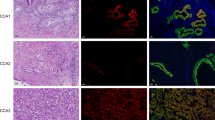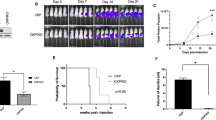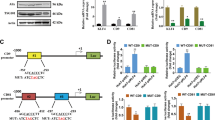Abstract
Scaffold proteins form multiprotein complexes that are central to the regulation of intracellular signaling. The scaffold protein ezrin–radixin–moesin-binding phosphoprotein 50 (EBP50) is highly expressed at the plasma membrane of normal biliary epithelial cells and binds epidermal growth factor receptor (EGFR), a tyrosine kinase receptor with oncogenic properties. This study investigated EBP50–EGFR interplay in biliary cancer. We report that in a collection of 106 cholangiocarcinomas, EBP50 was delocalized to the cytoplasm of tumor cells in 66% of the cases. Ectopic expression of EBP50 was correlated with the presence of satellite nodules and with the expression of EGFR, which was at the plasma membrane, implying a loss of interaction with EBP50 in these cases. In vitro, loss of interaction between EBP50 and EGFR was mimicked by EBP50 depletion using a small interfering RNA approach in human biliary carcinoma cells co-expressing the two proteins at their plasma membrane, and in which interaction between EBP50 and EGFR was validated. EBP50 depletion caused an increase in EGFR expression at their surface, and a sustained activation of the receptor and of its downstream effectors (extracellular signal-regulated kinase 1/2, signal transducer and activator of transcription 3) in both basal and EGF-stimulated conditions. Cells lacking EBP50 showed epithelial-to-mesenchymal transition-associated features, including reduction in E-cadherin and cytokeratin-19 expression, induction of S100A4 and of the E-cadherin transcriptional repressor, Slug, and loss of cell polarity. Accordingly, depletion of EBP50 induced the disruption of adherens junctional complexes, the development of lamellipodia structures and the subsequent acquisition of motility properties. All these phenotypic changes were prevented upon inhibition of EGFR tyrosine kinase by gefitinib. These findings indicate that loss of EBP50 at the plasma membrane in tumor cells may contribute to biliary carcinogenesis through EGFR activation.
This is a preview of subscription content, access via your institution
Access options
Subscribe to this journal
Receive 50 print issues and online access
$259.00 per year
only $5.18 per issue
Buy this article
- Purchase on Springer Link
- Instant access to full article PDF
Prices may be subject to local taxes which are calculated during checkout








Similar content being viewed by others
References
Bhattacharyya RP, Remenyi A, Yeh BJ, Lim WA . (2006). Domains, motifs, and scaffolds: the role of modular interactions in the evolution and wiring of cell signaling circuits. Annu Rev Biochem 75: 655–680.
Cardone RA, Bellizzi A, Busco G, Weinman EJ, Dell′Aquila ME, Casavola V et al. (2007). The NHERF1 PDZ2 domain regulates PKA-RhoA-p38-mediated NHE1 activation and invasion in breast tumor cells. Mol Biol Cell 18: 1768–1780.
Chen H, Zhu G, Li Y, Padia RN, Dong Z, Pan ZK et al. (2009). Extracellular signal-regulated kinase signaling pathway regulates breast cancer cell migration by maintaining slug expression. Cancer Res 69: 9228–9235.
Claperon A, Therrien M . (2007). KSR and CNK: two scaffolds regulating RAS-mediated RAF activation. Oncogene 26: 3143–3158.
Cortese MS, Uversky VN, Dunker AK . (2008). Intrinsic disorder in scaffold proteins: getting more from less. Prog Biophys Mol Biol 98: 85–106.
Curto M, Cole BK, Lallemand D, Liu CH, McClatchey AI . (2007). Contact-dependent inhibition of EGFR signaling by Nf2/Merlin. J Cell Biol 177: 893–903.
Dard N, Peter M . (2006). Scaffold proteins in MAP kinase signaling: more than simple passive activating platforms. BioEssays 28: 146–156.
Finzi L, Shao MX, Paye F, Housset C, Nadel JA . (2009). Lipopolysaccharide initiates a positive feedback of epidermal growth factor receptor signaling by prostaglandin E2 in human biliary carcinoma cells. J Immunol 182: 2269–2276.
Fouassier L, Duan CY, Feranchak AP, Yun CH, Sutherland E, Simon F et al. (2001). Ezrin–radixin–moesin-binding phosphoprotein 50 is expressed at the apical membrane of rat liver epithelia. Hepatology 33: 166–176.
Fouassier L, Rosenberg P, Mergey M, Saubamea B, Claperon A, Kinnman N et al. (2009). Ezrin–radixin–moesin-binding phosphoprotein (EBP50), an estrogen-inducible scaffold protein, contributes to biliary epithelial cell proliferation. Am J Pathol 174: 869–880.
Georgescu MM, Morales FC, Molina JR, Hayashi Y . (2008). Roles of NHERF1/EBP50 in cancer. Curr Mol Med 8: 459–468.
Guedj N, Zhan Q, Perigny M, Rautou PE, Degos F, Belghiti J et al. (2009). Comparative protein expression profiles of hilar and peripheral hepatic cholangiocarcinomas. J Hepatol 51: 93–101.
Hayashi Y, Molina JR, Hamilton SR, Georgescu MM . (2010). NHERF1/EBP50 is a new marker in colorectal cancer. Neoplasia 12: 1013–1022.
Henson ES, Gibson SB . (2006). Surviving cell death through epidermal growth factor (EGF) signal transduction pathways: implications for cancer therapy. Cell Signal 18: 2089–2097.
Hoque MT, Cole SP . (2008). Down-regulation of Na+/H+ exchanger regulatory factor 1 increases expression and function of multidrug resistance protein 4. Cancer Res 68: 4802–4809.
Knuth A, Gabbert H, Dippold W, Klein O, Sachsse W, Bitter-Suermann D et al. (1985). Biliary adenocarcinoma. Characterisation of three new human tumor cell lines. J Hepatol 1: 579–596.
Kreimann EL, Morales FC, de Orbeta-Cruz J, Takahashi Y, Adams H, Liu TJ et al. (2007). Cortical stabilization of beta-catenin contributes to NHERF1/EBP50 tumor suppressor function. Oncogene 26: 5290–5299.
Lambertini E, Franceschetti T, Torreggiani E, Penolazzi L, Pastore A, Pelucchi S et al. (2010). SLUG: a new target of lymphoid enhancer factor-1 in human osteoblasts. BMC Mol Biol 11: 13.
Lazar CS, Cresson CM, Lauffenburger DA, Gill GN . (2004). The Na+/H+ exchanger regulatory factor stabilizes epidermal growth factor receptors at the cell surface. Mol Biol Cell 15: 5470–5480.
Lee CH, Hung HW, Hung PH, Shieh YS . (2010). Epidermal growth factor receptor regulates beta-catenin location, stability, and transcriptional activity in oral cancer. Mol Cancer 9: 64.
Li M, Wang W, Soroka CJ, Mennone A, Harry K, Weiman EJ et al. (2010). NHERF-1 binds to Mrp2 and regulates hepatic Mrp2 expression and function. J Biol Chem 85: 19299–19307.
Lo HW, Hsu SC, Xia W, Cao X, Shih JY, Wei Y et al. (2007). Epidermal growth factor receptor cooperates with signal transducer and activator of transcription 3 to induce epithelial–mesenchymal transition in cancer cells via up-regulation of TWIST gene expression. Cancer Res 67: 9066–9076.
Masuda M, Kikuchi S, Maruyama T, Sakurai-Yageta M, Williams YN, Ghosh HP et al. (2005). Tumor suppressor in lung cancer (TSLC)1 suppresses epithelial cell scattering and tubulogenesis. J Biol Chem 280: 42164–42171.
Molina JR, Morales FC, Hayashi Y, Aldape KD, Georgescu MM . (2010). Loss of PTEN binding adapter protein NHERF1 from plasma membrane in glioblastoma contributes to PTEN inactivation. Cancer Res 70: 6697–6703.
Murthy A, Gonzalez-Agost iC, Cordero E, Pinney D, Candia C, Solomon F et al. (1998). NHE-RF, a regulatory cofactor for Na(+)–H+ exchange, is a common interactor for merlin and ERM (MERM) proteins. J Biol Chem 273: 1273–1276.
Reczek D, Berryman M, Bretscher A . (1997). Identification of EBP50: A PDZ-containing phosphoprotein that associates with members of the ezrin–radixin–moesin family. J Cell Biol 139: 169–179.
Sebastian S, Settleman J, Reshkin SJ, Azzariti A, Bellizzi A, Paradiso A . (2006). The complexity of targeting EGFR signalling in cancer: from expression to turnover. Biochim Biophys Acta 1766: 120–139.
Shibata T, Chuma M, Kokubu A, Sakamoto M, Hirohashi S . (2003). EBP50, a beta-catenin-associating protein, enhances Wnt signaling and is over-expressed in hepatocellular carcinoma. Hepatology 38: 178–186.
Song J, Bai J, Yang W, Gabrielson EW, Chan DW, Zhang Z . (2007). Expression and clinicopathological significance of oestrogen-responsive ezrin–radixin–moesin-binding phosphoprotein 50 in breast cancer. Histopathology 51: 40–53.
Stemmer-Rachamimov AO, Wiederhold T, Nielsen GP, James M, Pinney-Michalowski D, Roy JE et al. (2001). NHE-RF, a merlin-interacting protein, is primarily expressed in luminal epithelia, proliferative endometrium, and estrogen receptor-positive breast carcinomas. Am J Pathol 158: 57–62.
Takahashi Y, Morales FC, Kreimann EL, Georgescu MM . (2006). PTEN tumor suppressor associates with NHERF proteins to attenuate PDGF receptor signaling. EMBO J 25: 910–920.
Vondriska TM, Pass JM, Ping P . (2004). Scaffold proteins and assembly of multiprotein signaling complexes. J Mol Cell Cardiol 37: 391–397.
Weinman EJ, Steplock D, Shenolikar S . (1993). cAMP-mediated inhibition of the renal brush border membrane Na+–H+ exchanger requires a dissociable phosphoprotein cofactor. J Clin Invest 92: 1781–1786.
Werneburg NW, Yoon JH, Higuchi H, Gores GJ . (2003). Bile acids activate EGF receptor via a TGF-alpha-dependent mechanism in human cholangiocyte cell lines. Am J Physiol Gastrointest Liver Physiol 285: G31–G36.
Yoon JH, Gwak GY, Lee HS, Bronk SF, Werneburg NW, Gores GJ . (2004). Enhanced epidermal growth factor receptor activation in human cholangiocarcinoma cells. J Hepatol 41: 808–814.
Yoshikawa D, Ojima H, Iwasaki M, Hiraoka N, Kosuge T, Kasai S et al. (2008). Clinicopathological and prognostic significance of EGFR, VEGF, and HER2 expression in cholangiocarcinoma. Br J Cancer 98: 418–425.
Acknowledgements
We thank Yves Chrétien, UMRS_938, for statistical analysis, Anne-Marie Faussat, IFR65, for flow cytometry experiments and the Nikon Imaging Center, Institut Curie-CNRS Paris, for time-lapse microscopy. Confocal imaging was performed at the Cellular and Molecular Imaging facility of the IFR71-IMTCE (Faculty of Pharmacy, Paris Descartes University, Paris, France). This work was supported by grants from the Institut National du Cancer, Association pour la Recherche sur le Cancer and Fonds CSP (to CH). LF dedicates this work to RB Doctor and JG Fitz.
Author information
Authors and Affiliations
Corresponding author
Ethics declarations
Competing interests
The authors declare no conflict of interest.
Additional information
Supplementary Information accompanies the paper on the Oncogene website
Supplementary information
Rights and permissions
About this article
Cite this article
Clapéron, A., Guedj, N., Mergey, M. et al. Loss of EBP50 stimulates EGFR activity to induce EMT phenotypic features in biliary cancer cells. Oncogene 31, 1376–1388 (2012). https://doi.org/10.1038/onc.2011.334
Received:
Revised:
Accepted:
Published:
Issue Date:
DOI: https://doi.org/10.1038/onc.2011.334
Keywords
This article is cited by
-
Alteration in the sensitivity to crizotinib by Na+/H+ exchanger regulatory factor 1 is dependent to its subcellular localization in ALK-positive lung cancers
BMC Cancer (2020)
-
Terminal fucose mediates progression of human cholangiocarcinoma through EGF/EGFR activation and the Akt/Erk signaling pathway
Scientific Reports (2019)
-
cIAP1 regulates the EGFR/Snai2 axis in triple-negative breast cancer cells
Cell Death & Differentiation (2018)
-
Role of the PDZ-scaffold protein NHERF1/EBP50 in cancer biology: from signaling regulation to clinical relevance
Oncogene (2017)
-
Involvement of small ArfGAP1 (SMAP1), a novel Arf6-specific GTPase-activating protein, in microsatellite instability oncogenesis
Oncogene (2014)



